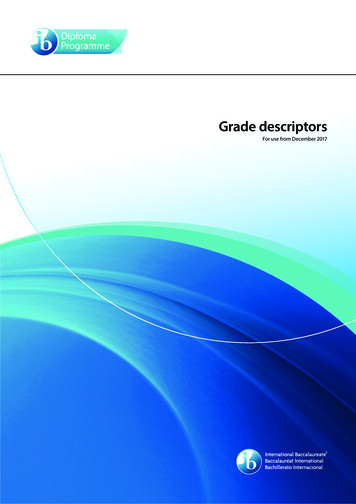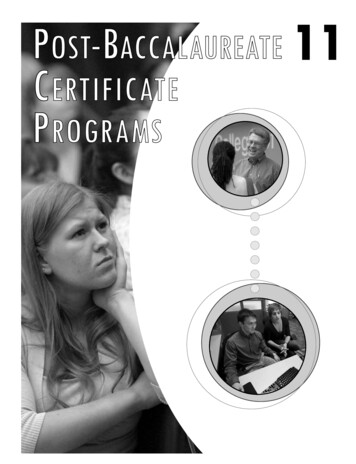
Transcription
Grade descriptorsFor use from December 2017
Grade descriptorsFor use from December 2017
Diploma ProgrammeGrade descriptorsPublished December 2017Published on behalf of the International Baccalaureate Organization, a not-for-profiteducational foundation of 15 Route des Morillons, 1218 Le Grand-Saconnex, Geneva,Switzerland by theInternational Baccalaureate Organization (UK) LtdPeterson House, Malthouse Avenue, Cardiff GateCardiff, Wales CF23 8GLUnited KingdomWebsite: www.ibo.org International Baccalaureate Organization 2017The International Baccalaureate Organization (known as the IB) offers four high-qualityand challenging educational programmes for a worldwide community of schools, aimingto create a better, more peaceful world. This publication is one of a range of materialsproduced to support these programmes.The IB may use a variety of sources in its work and checks information to verify accuracyand authenticity, particularly when using community-based knowledge sources such asWikipedia. The IB respects the principles of intellectual property and makes strenuousefforts to identify and obtain permission before publication from rights holders of allcopyright material used. The IB is grateful for permissions received for material usedin this publication and will be pleased to correct any errors or omissions at the earliestopportunity.All rights reserved. No part of this publication may be reproduced, stored in a retrievalsystem, or transmitted, in any form or by any means, without the prior written permissionof the IB, or as expressly permitted by law or by the IB’s own rules and policy. See http://www.ibo.org/copyright.IB merchandise and publications can be purchased through the IB store athttp://store.ibo.org.Email: sales@ibo.orgInternational Baccalaureate, Baccalauréat International and Bachillerato Internacionaland IB logos are registered trademarks of the International Baccalaureate Organization.
IB mission statementThe International Baccalaureate aims to develop inquiring, knowledgeable and caring young people whohelp to create a better and more peaceful world through intercultural understanding and respect.To this end the organization works with schools, governments and international organizations to developchallenging programmes of international education and rigorous assessment.These programmes encourage students across the world to become active, compassionate and lifelonglearners who understand that other people, with their differences, can also be right.
ContentsIntroduction1Group 1 (studies in language and literature) grade descriptors2Group 2 (language acquisition) grade descriptors4Group 3 (individuals and societies) grade descriptors10Group 4 (sciences) grade descriptors12Group 5 (mathematics) grade descriptors16Group 6 (arts) grade descriptors18Interdisciplinary subjects grade descriptors20Extended essay grade descriptors24Theory of knowledge grade descriptors26Grade descriptorsix
Diploma ProgrammeIntroductionThis document is a compilation of descriptions (grade descriptors) of each grade for each group of subjectsin the IB Diploma Programme. Grade descriptors consist of characteristics of performance at each grade.The descriptors apply to groups of subjects but substantial similarity exists across sets of group gradedescriptors.Senior examiners use these grade descriptors when determining grade boundaries for examination papersand coursework components. For each grade, qualities of a typical performance are given. However, thework of few candidates will be consistently characterised by a single grade descriptor, most work willdisplay some of the characteristics of more than one grade. Senior examiners therefore review the work ofmany candidates to determine a grade boundary—the lowest mark at which characteristics of a grade areconsistently shown in candidate work—allowing for some compensation across the different aspects.The grade descriptors are also intended to help teachers explain the academic requirements of the IBDiploma Programme to students, undertake formative assessment, report progress and predict candidates’grades.Grade descriptors1
Group 1 (studies in language and literature) gradedescriptorsStudies in language and literatureGrade 7Demonstrates: excellent understanding and appreciation of the interplay between form and contentin regard to the question or task; responses that may be convincing, detailed, independent in analysis,synthesis and evaluation; highly developed levels of expression, both orally and in writing; very gooddegree of accuracy and clarity; very good awareness of context and appreciation of the effect on theaudience/reader; very effective structure with relevant textual detail to support a critical engagement withthe thoughts and feelings expressed in the work(s).Grade 6Demonstrates: very good understanding and appreciation of the interplay between form and content inregard to the question or task; responses that are, mainly, convincing, as well as detailed and independentto some degree, in analysis, synthesis and evaluation; well-developed levels of expression, both orally and inwriting; good degree of accuracy and clarity; good awareness of context and appreciation of the effect onthe audience/reader; effective structure with relevant textual detail to support a critical engagement withthe thoughts and feelings expressed in the work(s).Grade 5Demonstrates: good understanding and appreciation of the interplay between form and content in regardto the question or task; responses that offer generally considered and valid analysis, synthesis and/orevaluation; good levels of expression, both orally and in writing; adequate degree of accuracy and clarity;awareness of context and appreciation of the effect on the audience/reader; clear structure with relevanttextual detail to support an engagement with the thoughts and feelings expressed in the work(s).Grade 4Demonstrates: adequate knowledge and understanding of the question or task; responses that are generallyvalid in analysis and/or synthesis; satisfactory powers of expression, both orally and in writing; few lapses inaccuracy and clarity; some awareness of context and appreciation of the effect on the audience/reader; abasic structure within which the thoughts and feelings of the work(s) are explored.Grade 3Demonstrates: some knowledge and some understanding of the question or task; responses that are onlysometimes valid and/or appropriately detailed; some appropriate powers of expression, both orally and inwriting; lapses in accuracy and clarity; limited awareness of context and appreciation of the effect on theaudience/reader; some evidence of a structure within which the thoughts and feelings of the work(s) areexplored.Grade 2Demonstrates: superficial knowledge and understanding of the question or task; responses that are ofgenerally limited validity; limited powers of expression, both orally and in writing; significant lapses in2Grade descriptors
Group 1 (studies in language and literature) grade descriptorsaccuracy and clarity; little awareness of context and appreciation of the effect on the audience/reader;rudimentary structure within which the thoughts and feelings of the work(s) are explored.Grade 1Demonstrates: very rudimentary knowledge and understanding of the question or task; responses that areof very limited validity; very limited powers of expression, both orally and in writing; widespread lapses inaccuracy and clarity; no awareness of context and appreciation of the effect on the audience/reader; veryrudimentary structure within which the thoughts and feelings of the work(s) are explored.Grade descriptors3
Group 2 (language acquisition) grade descriptorsLanguage B (HL)Grade 7Students speak with clarity and fluency; use a richly varied and idiomatic range of language very accurately;handle ideas effectively and skillfully with active and complex interaction; demonstrate a thoroughunderstanding of the meaning and purpose of written texts; have little difficulty with the most difficultquestions; recognize almost all the subtleties of specific language usage; write detailed and expressive textsdemonstrating an excellent command of vocabulary and complex structures with a consistently high levelof grammatical accuracy; demonstrate clarity of thought in the organization of their work and an ability toengage, convince and influence the audience.Grade 6Students speak clearly, fluently and naturally; use a varied and idiomatic range of language accurately;handle ideas effectively with active and full interaction; demonstrate a very good understanding of themeaning and purpose of written texts; have little difficulty with more difficult questions; recognize mostof the subtleties of specific language usage; write detailed texts demonstrating a very good command ofvocabulary and complex structures with a very good level of grammatical accuracy; adapt their writingappropriately to suit the intended audience and purpose; express their ideas and organize their workcoherently and convincingly.Grade 5Students speak mostly clearly and fluently; use a varied range of language mostly accurately; handle ideasmostly effectively with generally full interaction; demonstrate a good understanding of the meaning andpurpose of written texts; have some difficulties with more difficult questions; recognize some subtletiesof specific language usage; write fairly detailed texts demonstrating a good command of vocabulary witha good level of grammatical accuracy; show a reasonable ability to adapt their writing to suit the intendedaudience and purpose; express their ideas and organize their work coherently.Grade 4Students speak generally clearly; use a basic range of language correctly; handle ideas adequately withfull interaction at times; demonstrate an adequate understanding of the meaning and purpose of writtentexts; have some difficulties with almost all difficult questions and some average questions; recognize a fewsubtleties of specific language usage; write texts demonstrating an adequate command of vocabulary withan adequate level of grammatical accuracy; show some ability to adapt their writing to suit the intendedaudience and purpose; express their ideas and organize their work appropriately.Grade 3Students speak hesitantly and at times unclearly; use a simple range of language correctly at times; handleideas with some difficulty with fairly limited interaction; demonstrate some understanding of the meaningand purpose of written texts; have difficulties with questions of average difficulty; write texts demonstratinga basic command of vocabulary and some awareness of grammatical structure; produce an identifiable texttype; make some attempt at expressing their ideas and organizing their work.4Grade descriptors
Group 2 (language acquisition) grade descriptorsGrade 2Students speak hesitantly and generally unclearly; use a limited range of language often incorrectly; handleideas with difficulty and with restricted interaction; demonstrate a fairly limited understanding of themeaning and purpose of written texts; have difficulties with some easy questions; write texts demonstratinga fairly limited command of vocabulary and little awareness of grammatical structure; produce an identifiabletext type with limited success; make some attempt at basic organization; content is rarely convincing.Grade 1Students speak hesitantly and unclearly; use a very limited range of language mostly incorrectly; handleideas with great difficulty and with very restricted interaction; demonstrate a limited understandingof the meaning and purpose of written texts; have difficulties even with easiest questions; write textsdemonstrating a limited command of vocabulary and little awareness of grammatical structure; produce abarely identifiable text type; lack organization to an extent that content is unconvincing.Language B (SL)Grade 7Students speak clearly, fluently and naturally; use a varied and idiomatic range of language accurately;handle ideas effectively with active and full interaction; demonstrate a very good understanding of themeaning and purpose of written texts; have little difficulty with more difficult questions; write detailedtexts demonstrating a very good command of vocabulary and complex structures with a very good levelof grammatical accuracy; adapt their writing effectively to suit the intended audience and purpose; expresstheir ideas and organize their work coherently and convincingly.Grade 6Students speak mostly clearly and fluently; use a varied range of language mostly accurately; handle ideasmostly effectively, with generally full interaction; demonstrate a good understanding of the meaning andpurpose of written texts; have some difficulties with more difficult questions; write fairly detailed textsdemonstrating a good command of vocabulary with a good level of grammatical accuracy; adapt theirwriting appropriately to suit the intended audience and purpose; express their ideas and organize theirwork coherently.Grade 5Students speak generally clearly; use a basic range of language correctly; handle ideas adequately withfull interaction at times; demonstrate an adequate understanding of the meaning and purpose of writtentexts; have some difficulties with almost all difficult questions and some average questions; write textsdemonstrating an adequate command of vocabulary with an adequate level of grammatical accuracy; showa reasonable ability to adapt their writing to suit the intended audience and purpose; express their ideasand organize their work appropriately.Grade 4Students speak hesitantly and at times unclearly; use a simple range of language correctly at times; handleideas with some difficulty and with fairly limited interaction; demonstrate some understanding of themeaning and purpose of written texts; have difficulties with questions of average difficulty; write textsdemonstrating a basic command of vocabulary and some awareness of grammatical structure; show someability to adapt their writing to suit the intended audience and purpose; make some attempt at expressingtheir ideas and organizing their work.Grade descriptors5
Group 2 (language acquisition) grade descriptorsGrade 3Students speak hesitantly and generally unclearly; use a limited range of language, often incorrectly; handleideas with difficulty and with restricted interaction; demonstrate a fairly limited understanding of themeaning and purpose of written texts; have difficulties with some easy questions; write texts demonstratinga fairly limited command of vocabulary and little awareness of grammatical structure; produce anidentifiable text type; make some attempt at basic organization; content is rarely convincing.Grade 2Students speak hesitantly and unclearly; use a very limited range of language mostly incorrectly; handleideas with great difficulty and with very restricted interaction; demonstrate a limited understandingof the meaning and purpose of written texts; have difficulties even with easiest questions; write textsdemonstrating a limited command of vocabulary and little awareness of grammatical structure; produce anidentifiable text type with limited success; lack organization to an extent that content is unconvincing.Grade 1Students speak very hesitantly and unclearly; use a very limited range of language incorrectly; handleideas unsuccessfully and with very restricted interaction; demonstrate a very limited understanding of themeaning and purpose of written texts; have difficulties with almost all questions; write texts demonstratinga very limited command of vocabulary and very little awareness of grammatical structure; produce a barelyidentifiable text type; lack organization to an extent that content is confusing.Language ab initio (SL)Grade 7Receptive skills: students respond clearly and effectively to all basic and most complex information andideas.Interactive skills: students respond accurately, communicate effectively and demonstrate comprehension;pronunciation and intonation always facilitate the understanding of the message; students sustainparticipation and make good independent contributions. The message is always clear.Productive skills: students develop ideas well using an effective, logical structure; they successfully usea range of simple and some complex cohesive devices; they use both basic and complex grammaticalstructures accurately. However, they may make occasional errors in complex structures; they use variedand effective vocabulary and appropriate register; they demonstrate clear evidence of interculturalunderstanding where required.Grade 6Receptive skills: students respond clearly to all basic and most complex information and ideas.Interactive skills: students respond mostly accurately, communicate almost always effectively anddemonstrate comprehension; pronunciation and intonation almost always facilitate the understandingof the message; students almost always sustain participation and make independent contributions. Themessage is usually clear.Productive skills: students develop ideas well using a logical structure; they successfully use a rangeof basic and some complex cohesive devices; they use both basic and complex grammatical structures6Grade descriptors
Group 2 (language acquisition) grade descriptorsaccurately. However, they may make several errors in complex structures; they use varied vocabulary andappropriate register; they almost always demonstrate clear evidence of intercultural understanding whererequired.Grade 5Receptive skills: students generally respond clearly to basic and some complex information and ideas.Interactive skills: students respond accurately and generally demonstrate comprehension; pronunciationand intonation often facilitate the understanding of the message; students generally sustain participationand make some independent contributions. The message is often clear.Productive skills: students develop some ideas using a logical structure; they often use a range of basicand some complex cohesive devices; they use basic grammatical structures accurately. However, complexstructures are rarely accurate; they use a range of basic vocabulary and appropriate register; they oftendemonstrate evidence of intercultural understanding where required.Grade 4Receptive skills: students respond clearly to most basic information and ideas.Interactive skills: students respond accurately and demonstrate comprehension in simple exchanges;pronunciation and intonation usually facilitate the understanding of the message; students sustainparticipation in simple exchanges. The message is usually clear.Productive skills: students develop basic ideas using a logical structure; they use a range of simple cohesivedevices successfully; they use most basic grammatical structures accurately; they use basic vocabulary andappropriate register successfully; they usually demonstrate evidence of intercultural understanding whererequired.Grade 3Receptive skills: students sometimes respond clearly to basic information.Interactive skills: students sometimes respond accurately and sometimes demonstrate comprehension insimple exchanges; pronunciation and intonation sometimes facilitate the understanding of the message;students sometimes sustain participation in simple exchanges. The message is sometimes clear.Productive skills: students sometimes develop basic ideas; they sometimes use simple cohesive devicessuccessfully; they sometimes use basic grammatical structures accurately; they sometimes use basicvocabulary and appropriate register successfully; they sometimes demonstrate evidence of interculturalunderstanding where required.Grade 2Receptive skills: students rarely respond clearly to basic information.Interactive skills: students rarely respond accurately or demonstrate comprehension; pronunciation andintonation rarely facilitate the understanding of the message; students rarely sustain participation in simpleexchanges. The message is rarely clear.Productive skills: students rarely develop basic ideas; they rarely use simple cohesive devices; they rarelyuse basic grammatical structures accurately; they rarely use basic vocabulary or appropriate registersuccessfully; they rarely demonstrate evidence of intercultural understanding where required.Grade descriptors7
Group 2 (language acquisition) grade descriptorsGrade 1Receptive skills: students very rarely respond clearly to basic information.Interactive skills: students very rarely respond accurately or demonstrate comprehension; pronunciationand intonation very rarely facilitate the understanding of the message; students very rarely sustainparticipation in simple exchanges. The message is very rarely clear.Productive skills: students very rarely develop ideas; they very rarely use simple cohesive devices; theyvery rarely use basic grammatical structures accurately; they very rarely use basic vocabulary or appropriateregister successfully; they very rarely demonstrate evidence of intercultural understanding where required.Classical languages (Latin and classical Greek)Grade 7Demonstrates excellent content knowledge and understanding, conceptual and contextual awareness andcritical, reflective thinking. Responses are logical and structured, make very effective use of well-selectedexamples, demonstrate awareness of alternative points of view and provide clear evidence of interculturalunderstanding. Translations are very accurate and convey the meaning of the original text, with use ofgrammar and vocabulary that is appropriate for the original text.Highly effective research, investigation and technical skills are evident, as is the ability to analyse, evaluateand synthesize evidence in an insightful way.Grade 6Demonstrates very good content knowledge and understanding, conceptual and contextual awareness andcritical, reflective thinking. Responses are mostly logical and structured, make effective use of well-selectedexamples, demonstrate sufficient awareness of alternative points of view and provide clear evidence ofintercultural understanding. Translations are accurate and mostly convey the meaning of the original text,with use of grammar and vocabulary that is mostly appropriate for the original text.Effective research, investigation and technical skills are evident, as is the ability to analyse, evaluate andsynthesize evidence competently.Grade 5Demonstrates sound content knowledge and understanding, conceptual and contextual awareness, andcritical, reflective thinking. Responses are generally logical and structured, make good use of examples,demonstrate generally accurate awareness of alternative points of view and provide some evidence ofintercultural understanding. Translations are somewhat accurate and convey the general meaning of theoriginal text, with use of grammar and vocabulary that is generally appropriate for the original text.Good research, investigation and technical skills are evident; the ability to analyse, evaluate and synthesizeevidence is evident but not consistently developed.Grade 4Demonstrates secure content knowledge and understanding (although there are some gaps), someconceptual and contextual awareness, and some critical, reflective thinking. Responses are somewhatlogical and structured, make use of examples, demonstrate some awareness of alternative points of viewand provide some evidence of intercultural understanding. Translations are partially accurate and convey8Grade descriptors
Group 2 (language acquisition) grade descriptorssome meaning of the original text, with use of grammar and vocabulary that is somewhat appropriate forthe original text.Some research, investigation and technical skills are evident; the ability to analyse, evaluate and synthesizeevidence is evident but not consistently developed.Grade 3Demonstrates basic content knowledge and understanding, with some gaps, some conceptual andcontextual awareness, and some critical, reflective thinking. Responses are valid, but lack clarity andstructure, make use of limited examples, demonstrate limited awareness of alternative points of view andprovide limited evidence of intercultural understanding. Translations are rarely accurate but convey thebasic meaning of the original text, with use of grammar and vocabulary that is somewhat appropriate forthe original text.Basic research, investigation and technical skills are evident; the ability to analyse, evaluate and synthesizeevidence is not always shown.Grade 2Demonstrates little content knowledge and understanding, with significant gaps, little conceptual andcontextual awareness, and little critical, reflective thinking. Responses are rarely valid, lack clarity andstructure, make use of weak/inappropriate examples, demonstrate very little awareness of alternativepoints of view and provide very limited evidence of intercultural understanding. Translations are mostlyinaccurate and rarely convey the basic meaning of the original text, with use of grammar and vocabularythat is rarely appropriate for the original text.Limited research, investigation and technical skills are evident; the ability to analyse, evaluate and synthesizeevidence is rarely shown.Grade 1Demonstrates almost no content knowledge and understanding, conceptual and contextual awareness,or critical, reflective thinking. Responses are rarely valid, lack clarity and structure, make use of irrelevantexamples, demonstrate little or no awareness of alternative points of view and provide little or no evidenceof intercultural understanding. Translations are mostly inaccurate and very rarely convey the basic meaningof the original text, with use of grammar and vocabulary that is rarely appropriate for the original text.Very limited research, investigation and technical skills are evident; the ability to analyse, evaluate andsynthesize evidence is not shown.Grade descriptors9
Group 3 (individuals and societies) grade descriptorsIndividuals and societiesGrade 7Demonstrates: conceptual awareness, insight, and knowledge and understanding which are evident inthe skills of critical thinking; a high level of ability to provide answers which are fully developed, structuredin a logical and coherent manner and illustrated with appropriate examples; a precise use of terminologywhich is specific to the subject; familiarity with the literature of the subject; the ability to analyse andevaluate evidence and to synthesize knowledge and concepts; awareness of alternative points of viewand subjective and ideological biases, and the ability to come to reasonable, albeit tentative, conclusions;consistent evidence of critical reflective thinking; a high level of proficiency in analysing and evaluating dataor problem solving.Grade 6Demonstrates: detailed knowledge and understanding; answers which are coherent, logically structuredand well developed; consistent use of appropriate terminology; an ability to analyse, evaluate and synthesizeknowledge and concepts; knowledge of relevant research, theories and issues, and awareness of differentperspectives and contexts from which these have been developed; consistent evidence of critical thinking;an ability to analyse and evaluate data or to solve problems competently.Grade 5Demonstrates: a sound knowledge and understanding of the subject using subject-specific terminology;answers which are logically structured and coherent but not fully developed; an ability to provide competentanswers with some attempt to integrate knowledge and concepts; a tendency to be more descriptive thanevaluative (although some ability is demonstrated to present and develop contrasting points of view); someevidence of critical thinking; an ability to analyse and evaluate data or to solve problems.Grade 4Demonstrates: a secure knowledge and understanding of the subject going beyond the mere citing ofisolated, fragmentary, irrelevant or “common sense” points; some ability to structure answers but withinsufficient clarity and possibly some repetition; an ability to express knowledge and understanding interminology specific to the subject; some understanding of the way facts or ideas may be related andembodied in principles and concepts; some ability to develop ideas and substantiate assertions; use ofknowledge and understanding which is more descriptive than analytical; some ability to compensate forgaps in knowledge and understanding through rudimentary application or evaluation of that knowledge;an ability to interpret data or to solve problems and some ability to engage in analysis and evaluation.Grade 3Demonstrates: some knowledge and understanding of the subject; a basic sense of structure that is notsustained throughout the answers; a basic use of terminology appropriate to the subject; some ability toestablish links between facts or ideas; some ability to comprehend data or to solve problems.10Grade descriptors
Group 3 (individuals and societies) grade descriptorsGrade 2Demonstrates: a limited knowledge and understanding of the subject; some sense of structure in theanswers; a limited use of terminology appropriate to the subject; a limited ability to establish links betweenfacts or ideas; a basic ability to comprehend data or to solve problems.Grade 1Demonstrates: very limited knowledge and understanding of the subject; almost no organizational structurein the answers; inappropriate or inadequate use of terminology; a limited ability to comprehend data or tosolve problems.Grade descriptors11
Group 4 (sciences) grade descriptorsSciencesGrade 7Displays comprehensive subject knowledge and a thorough command of concepts and principles.Selects and applies relevant information, concepts and principles in a wide variety of contexts. Analysesand evaluates quantitative and qualitative data thoroughly. Constructs detailed explanations of complexphenomena and makes appropriate predictions. Evidences great proficiency in
2 Grade descriptors Group 1 (studies in language and literature) grade descriptors Studies in language and literature Grade 7 Demonstrates: excellent understanding and appreciation of the interplay between form and content in regard to the question or task; responses t










